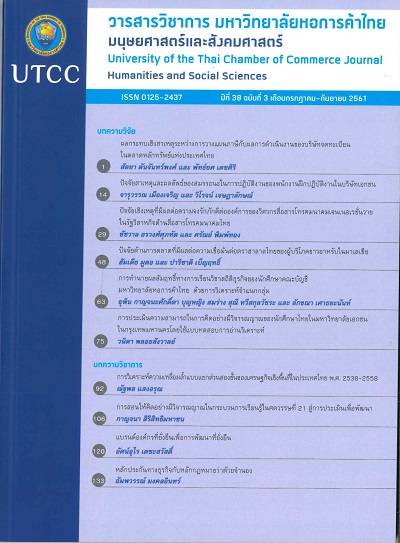An Assessment of Critical Thinking Skills of Thai Undergraduate Students in Private Thai Universities in Bangkok through an Analytical and Critical Reading Test
Main Article Content
Abstract
The purpose of this research was to assess the critical thinking of Thai undergraduate students in a sample of private Thai universities in Bangkok. The population studied was 6,436 English major students in Faculties of Humanities and Liberal Arts in a total of 12 private universities in Bangkok which offer analytical and critical reading courses to their English major students. The selected sample was 400 English major students who studied analytical and critical reading courses in 4 private Thai universities in Bangkok, taken from purposive sampling. The research instrument was an analytical and critical reading test. Collected data was analyzed by mean, standard deviation and statistical analysis of variance (ANOVA). Result of the study showed that
critical thinking of Thai undergraduate students in private Thai universities was at a low level with
a mean score of 5.93 marks (from the total score of 15 marks) with a standard deviation of 2.67.
Article Details

This work is licensed under a Creative Commons Attribution-NonCommercial-NoDerivatives 4.0 International License.
ลิขสิทธิ์ของบทความ
ผลงานที่ได้รับการตีพิมพ์ถือเป็นลิขสิทธิ์ของมหาวิทยาลัยหอการค้าไทย ห้ามมิให้นำเนื้อหา ทัศนะ หรือข้อคิดเห็นใด ๆ ของผลงานไปทำซ้ำ ดัดแปลง หรือเผยแพร่ ไม่ว่าทั้งหมดหรือบางส่วนโดยไม่ได้รับอนุญาตเป็นลายลักษณ์อักษรจากมหาวิทยาลัยหอการค้าไทยก่อน
References
Atagi, R. (2002). The Thailand educational reform project: School reform policy ADBTA 3585-THA. Retrieved May 5, 2015, from https://www.worldedreform.com/pub/fulltext2.pdf
Bloom, B. S., Engelhart, M. D., Furst, E. J., Hill, W. H., & Krathwohl, D. R. (1956). Taxonomy of educational objectives: The classification of educational goals. Handbook I: Cognitive domain. New York, NY: David McKay.
Chaiyawong, S. (2009). Research report: The relationship between grade point average and critical thinking ability of Higher Vocational Certificate Students, batch 13 (Dental Health) Public Health Science, Sirindhorn College of Public Health, Pitsanuloke. Pitsanuloke, Thailand: Province Prabaromarajchanok Institute, Ministry of Public Health. (in Thai).
Cottrell, S. (2011). Critical thinking skills developing effective analysis and argument (2nd ed.). China: Palgrave Macmillan.
Foundation for Critical Thinking. (2015). Defining critical thinking. Retrieved July 2, 2015, from https://www.criticalthinking.org/pages/defining-critical-thinking/766
Fredrickson, T. (2016, December 8). Pisa test rankings put Thai students near bottom of Asia. Bangkok Post. Retrieved from https://www.bangkokpost.com/ learning/advanced/1154532/pisa-test-rankings-put-thai-students-near-bottom-of-asia
Graham, S. (2010, January 12). Critical thinking. Bangkok Post. Retrieved from https://www.bangkokpost.com/learning/education-features/30887/critical-thinking
Jariyathitinant, P. (2002). Use of critical reading strategies to promote critical reading and thinking of undergradute students (Unpublished Master’s Thesis). Chiang Mai University, Thailand.
Krejcie, R. V., & Morgan, D. W. (1970). Determining sample size for research activities. Educational and Psychological Measurement, 30, 607-610. Retrieved from https://home.kku.ac.th/sompong/guest_speaker/KrejcieandMorgan_article.pdf
Kurland, D. J. (2010). How the language really works: The fundamentals of critical reading and effective writing. Retrieved July 2, 2015, from https://www.criticalreading.com/
Lau, J., & Chan, J. (2015). [C01] What is critical thinking? Retrieved July 2, 2015, from https://philosophy.hku.hk/think/critical/ct.php
Lipman, M. (2003). Thinking in education. Cambridge, UK: Cambridge University Press.
Lohatepanont, K. (2017, 9 July). Towards Thailand 4.0 [Web log message]. Retrieved from https://kenlwrites.com/2017/01/08/towards-thailand-4-0/
Mendes, J. L. (2017, November 17). Why critical thinking skills are important in the workplace [Weblog message]. Retrieve from https://www.ziprecruiter.com/blog/why-critical-thinking-skills-are-important-in - the-workplace/
OECD. (2016). PISA 2015 results in focus. Retrieved from https://www.oecd.org/pisa/pisa-2015-results-in-focus.pdf
Office of the Higher Education Commission. (2016). Higher educational information. Retrieved July 2, 2017, from https://www.info.mua.go.th/information/show all_statdata_table.php?data_show=2
Office of Higher Education Commission. (2017). Educational statistics: Number of students academic year 2016 allocated by TYPES / NAMES / 8 GROUP_ISCED / ISCED_NAME / PROGRAM_NAME / levels of education and sex. Retrieved July 2, 2016, from https://www.info.mua.go.th/information/show_all_statdata_table.php?%20data_show=2
(in Thai).
Office of the National Education Commission. (n.d.). National Education Act of B.E.2542 (1999). Retrieved from https://asean.org/storage/2016/08/Thailand184.pdf
Pathanasethpong, A. (2014, October 6). Critical thinking? Perish the thought. Bangkok Post. Retrieved from https://www.bangkokpost.com/ opinion/opinion/436130/critical-thinking-perish-the-thought
Royal Thai Embassy, Wahington D.C. (2015). Thailand 4.0. Retrieved February 12, 2018, from https://www.thaiembdc.org/thailand-4-0-2
Shaaban, K. A. (2014). Assessment of critical thinking skills through reading comprehension. International Journal of Language Studies, 8(2), 117-140.
SkillsYouNeed. (2015). Critical thinking skills. Retrieved July 2, 2015, from https://www.skillsyouneed.com/learn/critical-thinking.html
Smith, G. F. (2003). Beyond critical thinking and decision making: Teaching business students how to think. Journal of Management Education, 27(1), 24–51.
Terry, N., & Ervin, B. (2012). Student performance on the California critical thinking skills test. Academy of Educational Leadership Journal, 16 (Special Issue), 25-34.
Tilus, G. (2012, November 12). 6 Critical thinking skills you need to master now [Web log message]. Retrieved from https://www.rasmussen.edu/student- life/blogs/main/critical-thinking-skills-you-need-to-master-now/
Yamane, T. (1967). Statistics, an introductory analysis (2nd ed.). New York, NY: Harper and Row.
Zin, Z. M., Wong, B. E., & Rafik-Galea, S. (2014). Critical reading ability and its relation to L2 proficiency of Malaysian ESL learners. 3L: The Southeast Asian Journal of English Language Studies, 20(2), 43-54.
doi:https://dx.doi.org/10.17576/3L-2014-2002-04


